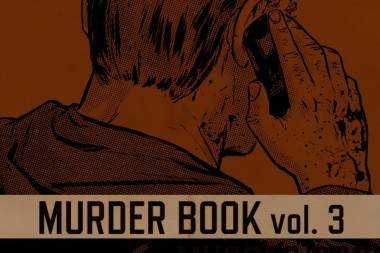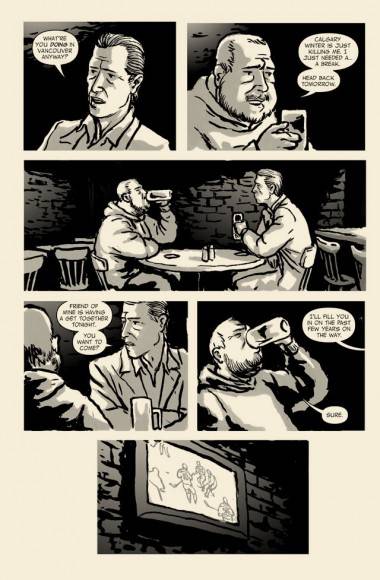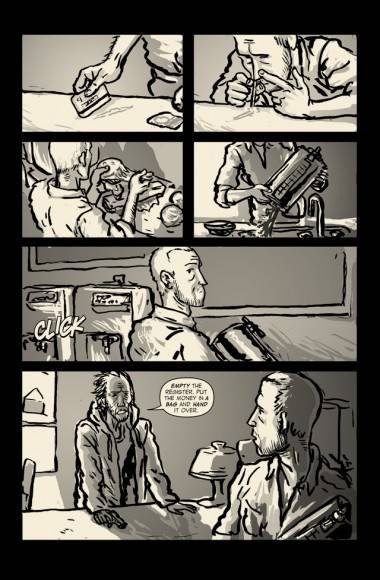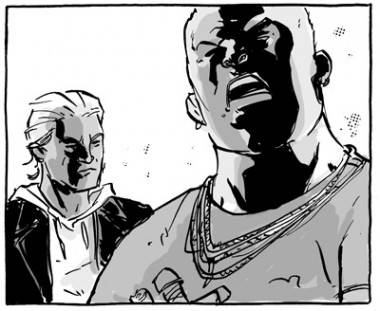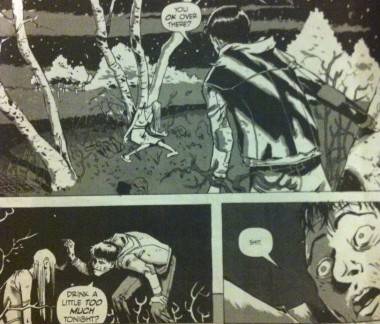Interview – Vancouver comics writer Ed Brisson
– by Ryan Ingram
In police-speak, a “murder book” is referred to as the case-file that holds all the clues in a homicide investigation, from crime-scene photographs to autopsy reports. But in the comic book series Murder Book, the pages are filled with the tense, brutal moments leading up to a killing.
In three issues, writer Ed Brisson has told six short tales that are big on twists, and generally end with the same grim punch line – murder. But it’s everything leading up to the bleak final panels that make Murder Book something worth being an accomplice to.
The most recent issue features an escalating drug-money collection, and a very unlucky walk-in-the-park, with art by fellow Vancouverites Jason Copland (“Kill All Monsters!”) and Johnnie Christmas (“Spectre of Sound”).
Brisson has been a comics letterer since 2006, but Murder Book is the first series he’s written. (He wrote a short story that was included in crime anthology Acts of Violence). But the Vancouverite always had a foot in comics, from publishing his first comic at 18, starting up a web-comic in 2004, and dabbling in humour and auto-bio comics along the way.
He took to the time to answer some emails about Murder Book,using Vancouver as a setting and even Captain Canuck.
Ryan Ingram: Why did you gravitate towards writing about the murky world of crime and murder?
Ed Brisson: It’s a confluence of a few things. First, what is probably the strongest influence on my writing – my father was a cop and my mom worked for years in victim services, dealing with sexual assault victims, generally right after the assault. Both talked about work a lot at home and I would soak it all in. As a kid, this stuff was fascinating and terrifying to me.
Later, in college, I discovered Elmore Leonard and went nuts. In the first month that I started reading him, I read more than 20 of his books. From there, I discovered other crime writers: Richard Stark, Jim Thompson, Charles Willeford, Carl Hiaasen, and on and on. Right around that time, I started watching a lot of crime films – especially gritty ’70s American and Italian films.
When I first started to pitch comics to publishers, probably about six or seven years ago, I was writing all these superhero comics that were thinly veiled crime comics. At the time, there were no other crime comics being published (this was about a year before [Ed] Brubaker launched Criminal) and I just assumed that no publisher would be interested in something that didn’t involve superheroes.
While I was pitching these, a friend called me on my shit. Told me to give up superheroes and just write crime. He was right, I knew it. I was writing what I thought people would want and not what I wanted which, in retrospect, was embarrassing.
About that time I started to put together plans with a group of creators to launch Acts Of Violence – a collection of crime stories and, essentially, a proto-Murder Book for me.
RI: Have you had the chance to do any crazy crime research? Any police ride-alongs?
EB: When I was younger, I hung out with some shady kids. This is young, young. Like 13-14. I used to get in all sorts of trouble, but luckily never got caught for any of it. Around the time that I was 15 or 16, I smartened up and stopped fighting, stealing and the other shit. So, there is some childhood deviancy to pull from.
I do A LOT of reading – I have three books on the go at all times. I also watch a lot of documentaries and movies. I’ll sometimes pull nuggets from these. Germs of ideas will get planted to expand on later.
Also: having an ex-cop for a dad is good for research too. I can just call him up or shoot him an email and ask him about how the police might handle a situation or if he’d ever dealt with a case involving something in particular. Although, I’m not always convinced that he always believes I’m doing research.
RI: Was the decision to set the stories in Vancouver based on more than that it’s home for you?
EB: Basically, yeah. I knew that it would be a bit of an uphill battle. Anecdotally, I know that if you set a story in a city that is NOT a U.S. city, then you automatically lose the interest of a lot of American readers. The easier route would have been to set it in Seattle or Portland (or some sort of American Vancouver proxy), but I didn’t want to do that. I wanted to set something here. I love this city and think that it makes a great backdrop for the stories.
Murder Book is me doing what I want to do. Telling the stories I want, so I’m going to set the stories where I think they’ll fit best. If someone’s not going to read them because they’re set in Canada, then it’s their loss.
RI: You’ve had five different artists tell six of the short stories so far — how do you choose which artist will work on which story? Has the collaboration between each artist been different?
EB: Typically, I’ll write the stories after I’ve found an artist. That way, I’m writing with them in mind and think about things that they like to draw or try to play to their strengths (or, in some cases, write something that they normally wouldn’t draw). I generally talk the stories out with the artists before writing the scripts, I like having the artist in on the process.
I started out illustrating my own comics, so feel like I have an advantage over other writers in that I have experience being on the other side of the script. I feel like I have a decent understanding of WHAT I’m asking from artists and how to ask for it. Also, I’m not super stringent that they always stick exactly to my script. I trust that if an artist has a better idea on how to get the story across, that it probably is. I don’t know of any occasion that an artist has made a change where I asked them to change it back.
While writing “Fathers & Sons” (Murder Book Vol. 3), Jason [Copland] and I were talking a lot. He’s someone who I’ve been bugging to do a story for years. I was working on the story, but definitely dragging my ass on it and Jason only had a certain window that he could do the story. One day, he dropped me an IM that read: “Tick tock, Ed. Tick Tock.” Which I then stole and put into the script.
Johnnie Christmas, who drew “Midnight Walk” in Murder Book Vol. 3, and I did an actual walk through of Trout Lake (where the story takes place) while I was working on the script. By doing this I made some minor changes and added details that I wouldn’t have otherwise done, had I not done that walk through with the artist.
As a collaborator, Johnnie made my already-dark story so much darker. The story made me cringe after reading (in a good way). Before sending it to press, I was about to change the last line of the story, which is really like a final kick in the nuts to the protagonist, but John talked me off the ledge. I was worried that it would come across as too much, thankfully he was there to talk me out of what would have been a terrible mistake.
I think that each collaboration has been great, but I tend to gravitate towards artists who are going to get invested in the story. It’s not an accident that I’m working on other projects with more than half of my Murder Book collaborators.
RI: Some of the stories are subtly connected. Is this something that’s going to continue to reveal itself? Will there be more reccurring characters interacting in new stories?
EB: My plan is to have about half the stories have a loose connection. The connection will play out in the background and won’t be something people need to know in order to enjoy the stories, it’s more of an Easter egg, or another layer for those who are reading all the stories. Not knowing the back story won’t take away from the shorter stories, but knowing it WILL add more to the stories.
RI: You’ve mentioned that more Murder Book stories will be back-up stories in some new comics from Image. Can you tell us more about when and where they’ll be appearing?
EB: Jason and I are going to be running new Murder Book stories in the back pages of Near Death starting with #8 which is due out sometime in May from Image.
Johnnie Christmas and I did a story that will be appearing in the back of Grim Leaper #4 (due August 2012 from Image/Shadowline). There are a couple others in the works too, but until there’s something more official to say, I won’t get into it – I’d hate to say that they’re going to appear in book X, only to have things change in the coming months.
I’ve also signed a publishing deal in the past month, but am not allowed to talk about it too much until it’s officially announced by the publisher. All I can say right now is that Michael Walsh [artist on story “Settling Up” in issue 2] and I will have a five issue mini-series that debuts in November of this year. Readers of Murder Book should enjoy it – although it’s got a bit of a sci-fi angle to it.
RI: Also, you recently showed off a bunch of sketches you’ve got from artists drawing Captain Canuck. What does the character mean to you?
EB: I love Captain Canuck.
Captain Canuck was one of the first comics I started reading as a kid. I used to buy them in three-packs for 99 cents from BiWay (a discount store chain in Ontario). I just liked the idea that Canada had its own superhero. The comic is pretty silly, but I still love it.
Writing a Captain Canuck mini-series is on my bucket list, and that comes from a dude who doesn’t have a whole lot of love for superhero comics.

